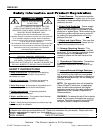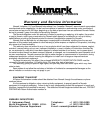
DM2000X
DM2000X FRONT PANEL DIAGRAM...
2
1
3
4
5
6
7
8
9
11
10
12
14
13
16
17
1415
GUIDED TOUR OF FEATURES AND
OPERATING INSTRUCTIONS...
If the DM2000X is your first mixer, please read this
entire manual before you begin operation.
If you are an experienced DJ simply replace your old
mixer. The DM2000X can be 10” rack-mounted or
used as a free-standing unit. Keep in mind that there are
a few features you may never have seen before in a
mixer of this type that you will need to read about.
INSTALLATION AND OPERATION
Study the Connections Diagram on page 13. First,
connect all stereo input sources. Next connect your
microphone(s) and monitor headphones. Make sure all
faders are at "zero" and the unit is off. Finally, connect
the stereo outputs to the power amplifier(s) and/or
audio sources. Plug the DM2000X into AC power.
Now you are ready to switch it on.
CHANNEL FEATURES
1. Channels 1, 2, & 3 Rotatable Input Toggle
Switches select which source will be live to that
channel based on what you have connected to the rear
panel input section.
To rotate or replace the toggle
a. Turn off all power!
b. Remove corner screws
c. To rotate lift of toggle and place in it’s new
position or to replace unplug the old unit and
plug in the new one.
d. Screw toggle back into place.
2. The Input Faders are low-noise, low-impedance,
high-quality, smooth Alps™ faders. These control
individual source levels in the mix.
3. PFL and Channel Cue Assign. The PFL
pushbuttons are used to route channel audio to the
main volume meter and the Cue Monitor Section.
When a PFL is pressed the main volume meter
changes its display to the PFL channel. This allows the
DJ to accurately match levels before mixing with that
channel’s gain control. The idea is to properly match
inputs, not the input with the output!
4. Send Buttons are for allowing a channels pre-fader
output to be sent to the send connectors in the rear of
the unit. These are used for sampling and other special
effects. You would return the send signal through
another input channel.
5. Treble, Mid, and Bass Controls are for setting
appropriate equalized levels for the music you are
playing. When turn all the way left they “CUT” the signal
by 30dB for special effects mixing.
6. Gain Controls are for accurately matching audio
levels of the channels.
Numark - The Proven Leader in DJ Technology
©1997 Numark Industries 6 http://www.numark.com














